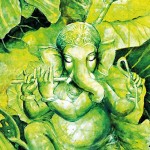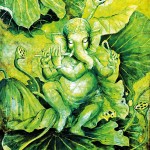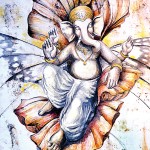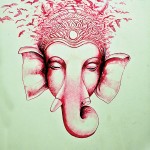The deity as a mirror to the soul
View(s):- A full time devotee of Ganesh, artist Mahen Chanmugam is getting ready for his latest exhibition, Ganeshism5
By Yomal Senerath-Yapa
So it comes as a surprise that he is currently working on a canvas depicting – of all things- an unfurling plant. It is enthroned on his easel, bathed in the subaqueous dusk that filters into his Nawala atelier at 5.30 p.m… Mutiny at last?
No; looking closer you see that the lush leaves are framed to show a clear silhouette of that familiar unfurling trunk, those fan-like ears and that rotund, playful poise.
Now getting ready for his latest exhibition, Ganeshism5, to be held at the Barefoot Gallery from June 1 to 24, Mahen says the portrait is testimony to one of his mantras- ‘One man’s god is another’s nature’.
Mahen is now full-time devoted to Ganesh. However, his fascination is ‘not religious but spiritual’- meaning the elephant headed deity is for him an energy, and his paintings are a way to give a shape to that energy ‘so that we have a point of focus in our meditation’.
Each Ganesh is unique and explores contemporary interpretations of the god’s complex iconography and symbolism- there was a Ganesh in a black and blue football jersey in protest of the Bali bombing and one with a nude woman’s torso.
Everywhere you turn in his house-gallery, the son of Parvati is looking into you with his doe eyes imparting something cosmic.
As with the arboreal Ganesh the collection shows “the subjective nature of human perception and interpretation of divinity, as well as the influence of cultural and personal beliefs on our understanding of the world”. There is no one ‘correct’ way of seeing or understanding the world, and different perspectives and beliefs can coexist and be equally valid.
It is the narrow hill path to self-realization that Mahen trudges as did before him many a searcher, with his art. “The nature of consciousness, the concepts of inner worlds, the interconnectedness of all things, and the relationship between humanity and the universe” – these are some of his themes.
Symbolism, metaphor, and allegory convey spiritual and philosophical ideas: one of his favourite images is the Ganesh whose crown breaks into a hundred birds escaping the corporeal prison like pigeons at dawn against a pink sky.
Most canvases have what Mahen now finds an alluring image to hone in on: the human silhouette, with Ganesh peeping out from within.
This, says Mahen, is “a celebration of our individual freedom to investigate spiritual truth outside the dogmas of religion, and to personally experience a spiritual dimension within ourselves.”
While Mahen seems to rail against religion, it is really over what we have made of religion that he despairs.
“Most deities have been shorn of their philosophical significance and reduced to mere superstition,” he says, adding that Ganesh is really the symbol of gravity while his father Shiva symbolises nuclear energy and his brother Lord Murugan, electromagnetic energy.
“This collection of paintings attempts to create an inward discussion, to debate, question and meditate on the deep truths represented by the symbols. It aims to dispel the singular concept of the ‘favour granting god’ and focus instead, on the deity, as a mirror to the soul.”
Mahen gets up at ‘unholy hours’- usually 3 in the morning and works till five to six in the evening after which he generally cannot work.
“A lot of people are coming to view the gallery now, but I rarely leave the house,” he says, as contented as a hermit. “Colombo can be a bit painful to be in.”
Ganeshism5 will be on at the Barefoot Gallery from June 1 to 24.
Searching for that next furry family member but couldn’t find one in your area? Hitad.lk has the solution with our extensive listings of dogs for sale in Sri Lanka!






